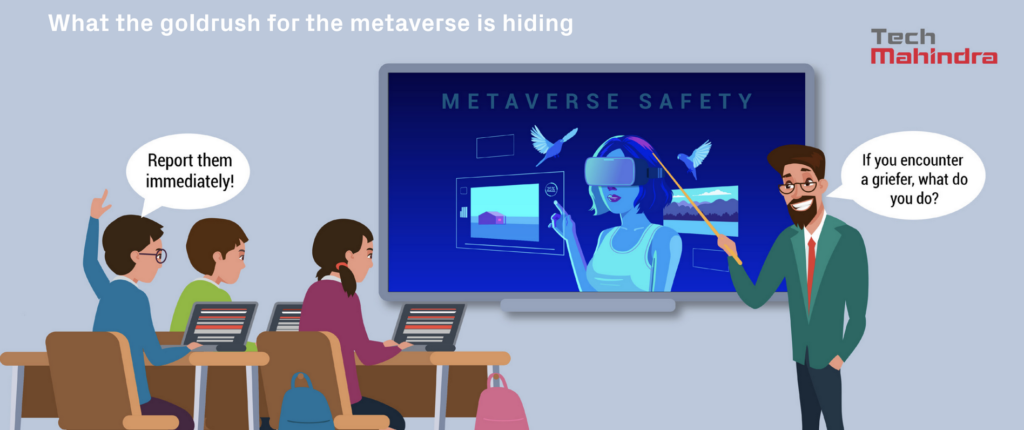M+E Daily

M&E Journal: High Risk, High Reward
Story Highlights
When 71-year-old Bob Iger jumps on the bandwagon and joins a virtual avatar company, it’s a sign the metaverse has morphed into the next big thing in tech.
Maybe it doesn’t take much to get us excited anymore, or perhaps it’s Facebook’s extensive rebrand as Meta. Either way, the metaverse is the proverbial pot of gold at the end of the rainbow, with every tech company worth its salt cashing in and announcing a new offering. But first, a word of caution.
HIGH REWARD, HIGH RISK
It’s easy to forget that within the metaverse exist many of the same problems on the internet today: trolls, harassment, data security and privacy issues.
In 2021, research by the Center for Countering Digital Hate, a UK/U.S. nonprofit, found that Facebook’s VR Chat — a virtual world platform accessed on Meta’s Oculus headset — featured abundant instances of racism, misogyny, pornography, harassment, and abuse, often in the presence of minors.
 In another example that illustrates the safety and privacy concerns with the metaverse, earlier this year, Jelly, China’s viral metaverse app, was taken offline on suspicion of data malpractice after users reported a glut of spam and marketing calls post-sign-up.
In another example that illustrates the safety and privacy concerns with the metaverse, earlier this year, Jelly, China’s viral metaverse app, was taken offline on suspicion of data malpractice after users reported a glut of spam and marketing calls post-sign-up.
Evidently, building a multi-user 3D world where people can safely ‘exist’ means building safety guardrails to ensure everyone has a good experience. The fact that activities can take place virtually doesn’t mean the rules are any different. But abusers and rotten eggs will need reminding of this fact.
Women have taken to Reddit and other forums to discuss the alarming lack of boundaries in the metaverse. They recount experiences of being stalked, assaulted, touched inappropriately, and even issued rape threats. Frighteningly, this affects minors too.
Just because it’s online doesn’t make it less traumatic, as mental health practitioners have attested. Abuse, albeit virtual, also has real, damaging psychological consequences. Today, as with almost any online property worth its salt, many nefarious avatars walking the metaverse, giving grief to others.
They give new users irrelevant or misleading instructions in attempts to take them off course and even steal their hard-earned crypto tokens.
The physical user interface of the metaverse, such as VR headsets, is a critical piece of the puzzle and needs to be secured against unauthorized access to prevent theft of sensitive data. IPR and copyright matter too, especially when individuals and organizations exist as virtual avatars.
“Black Mirror” may have sounded far-fetched at the time, but a dystopian future where the spread of fake news, misinformation and surveillance takes on more teeth in a virtual environment, is very much a possibility. Within VR worlds, propaganda, conspiracy theories and distortion can spread with speed and impunity, aided by the immersive quality of these technologies.
Privacy — already a chimera of Web 2.0 — is also a big concern in the metaverse, now that we know the risks of technologies such as AI and facial recognition, which have been deployed with malicious intent.
MAKE IT SAFE
Protecting metaverse users against these types of behaviors and dangers requires both technological solutions as well as social ones. There is some recognition of this need. China has set up the Metaverse Industry Committee, an entity to regulate the development of metaverse and related technologies.
After receiving multiple reports of groping on its social VR platform Horizon Worlds, Meta ne‘e Facebook introduced the ‘Personal Boundary’ feature. It allows avatars to place a four-foot barrier — a bubble — around themselves to prevent groping. In Horizon Worlds, users can block, mute harassers, and report them.
 But a lot more needs to be done. While the high- way to Web 2.0 is littered with grim reminders of the inability of tech platforms to effectively self-regulate and instead of succumbing to the lure of monetizing our attention, there are still important lessons worth learning.
But a lot more needs to be done. While the high- way to Web 2.0 is littered with grim reminders of the inability of tech platforms to effectively self-regulate and instead of succumbing to the lure of monetizing our attention, there are still important lessons worth learning.
Data storage and access policies need to become more stringent. Organizations need to conduct rigorous verification of the third parties they exchange data with. Sensitive data generated within these virtual worlds must be protected and continually monitored at every level, beyond mere authentication and authorization.
Until metaverse creators get around to implementing robust self-regulation and self-moderation, the least we can do is to have tech-enabled solutions. Possible safety measures could include smart storage solutions like Video Storage and Processing Platforms (VSPP) that can record and identify offenders close to real-time.
AI-driven speech analysis that can identify hate speech and harassment could be one way of identifying misuse and eliminating griefers on these platforms. AI-driven metadata extraction from metaverse video can help weed out offenders when needed.
The metaverse is uncharted territory.
It is being figured out as we chug along, and AI may not present all the right solutions. Till tech catches up, there’s always the good old “send more people to fix the problem” approach to augment technology shortcomings.
By Jay Chauhan, Group Practice Head, M&E, Tech Mahindra
=============================================
Click here to download the complete .PDF version of this article
Click here to download the entire Spring 2022 M&E Journal









